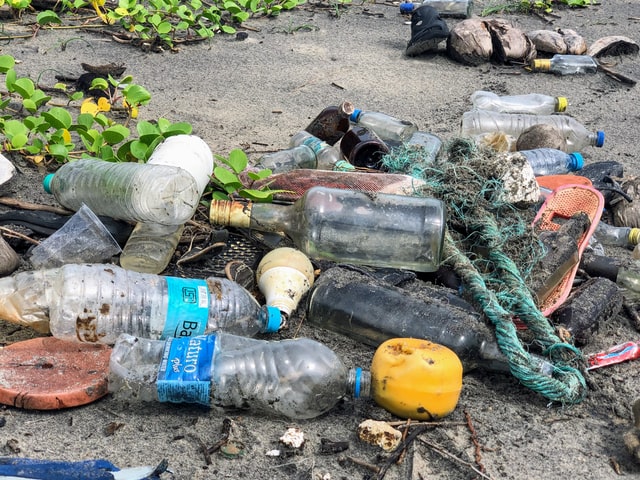Sundarbans tries to find relief from plastic waste
Days after it was battered by one of the most powerful cyclones of recent times, Yaas, for the residents of the Sundarbans, one of three largest mangrove forests in the world and the biggest in Asia, the rapid arrival of relief material, including water and food, was a very welcome sight. It helped them overcome, at least partially, the devastation caused by the cyclone.
But a few weeks later, the relief material itself has turned into a big problem as most of it was packaged in plastics and the toxic material now threatens the sensitive ecology of the jungle that is home to the Royal Bengal Tiger, the largest and most majestic species of tigers in the world.
Experts working with various environmental NGOs raised an alarm at the rapidly increasing accumulation of plastic waste in the remote islands of the fragile ecosystem. Ecologists have long been wary of the issue and had issued warnings about the packaging, as early as June, days after Yaas had inundated a large portion of the Sundarbans.
Experts and ecologists estimate that around 56 tonnes of plastic has been accumulated just in Gosaba, on one of the 50 inhabited islands sprinkled around the Sundarbans. Experts say they would struggle to estimate the total amount of plastics that has accumulated on all the inhabited parts of the Sundarbans. They are worried that plastic has now also made it to remote areas in the forest such as Mousuni, Bali, Patharpratima and Kultali. Mahajibon, an NGO, says it has recovered 300 kg of plastic waste from just one block, and that too days after the cyclone had hit the area.
Plastic pollution perils
Incidentally, it is not just the cyclone that is to be blamed for the plastic menace. Environmental groups and forest conservation officials say the lion’s share of blame for the pollution in tiger territory lies with the tourists that have been flocking to these forests over the past several in hope of sighting the tigers. They say that the tourists leave behind heaps of plastic waste that is strewn all over the forest.
According to Tuhin Ghosh, director of the School of Oceanographic Studies of Jadavpur University, the pollution caused by plastic will have a long-term impact on the Sundarbans’ ecosystem. He explains that plastic in saline water over long periods of time will increase the toxicity level of the water which will lead to eutrophication of water, harming both aquatic life and other fauna who will be drinking that water. Further he added that presence of plastic in water will also lead to an eventual increase of microplastics in water that will have an adverse impact on the food chain. He concludes by saying that the water of the Sundarbans basin flows to the oceans and seas, thus this will provide access to all that plastic waste to large water bodies.
Experts have reasserted in their analysis that Sundarbans is home to a population of 5 million, which is largely dependent on fisheries and aquaculture. Thus, change in the systematised ecosystem of the Sundarbans can turn out to be a major detriment to the livelihoods of many. Adding to the predicament, Sundarbans is also a UNESCO world heritage site, being home to 2,626 fauna that includes Royal Bengal Tiger, Gangetic dolphins, saltwater crocodiles and endangered species of freshwater turtles, along with 428 distinct species of birds. The rising pollution caused by plastic waste is becoming a major threat to this rich biodiversity of the region.
In response to the situation the government, in partnership with many NGOs such as the Mahajibon, has started a project termed money-for-plastic in which the local inhabitants of the region will be paid in return of their support in the cleanliness drive. The aim of the project is to prevent further dumping of plastic in land and water, in which the local villagers can play a pivotal role. In terms of livelihood, the project is in a major way contributing to the sustenance of many whose routine modes of earning have been hit adversely due to the pandemic.
Like, for example, the 240,000 people living in the Gosaba community block alone, of which 38 pc are said to be below the poverty line as per the 2011 census. Along with providing monetary incentive to the locals for collecting plastic, this step has also provided a platform for the many self-help groups for women to emerge and reorganise themselves. The money for West Bengal’s first plastic buy-back project is being raised through donations by private institutions, and the several NGOs have also initiated crowd-funding for the same.
Vikrant Tongad, who is the founder of social action for forest and environment, an NGO based in Uttar Pradesh, says, “The microplastics, one of the most harmful elements that plastic possesses,is disastrous not only for the environment but also human health. The programme initiated by the government shouldn’t only be a visual representation that people will applaud from a distance, more important than that is the sustenance of the local ecology, to make it rich as it is naturally meant to be. The task cannot be left solely on the shoulders of the government and NGOs, involving the local populace is a must to ensure lasting effectiveness as has been initiated in the Sundarbans. Like in Mumbai, a popular volunteer-oriented cleanliness drive had begun in Versova beach in 2015 which shows that involving the common people fastens the process and has lasting impact when it comes to responsible behavior.”
Thus, the rise in pollution in the Sundarbans countered by initiatives such as the money-for-plastic project involving both the people and the government is a big step towards change and perspective in view of conservation of the environment.










